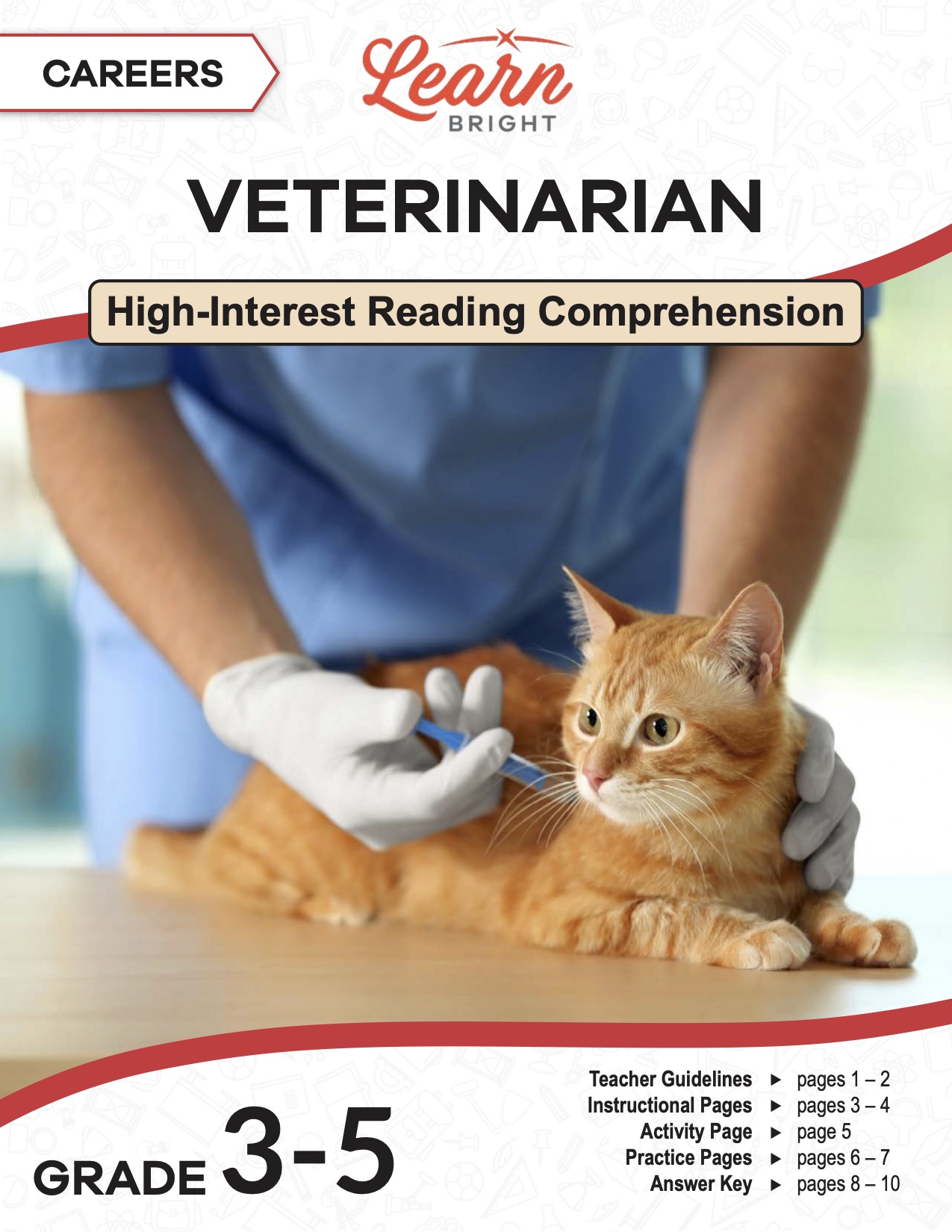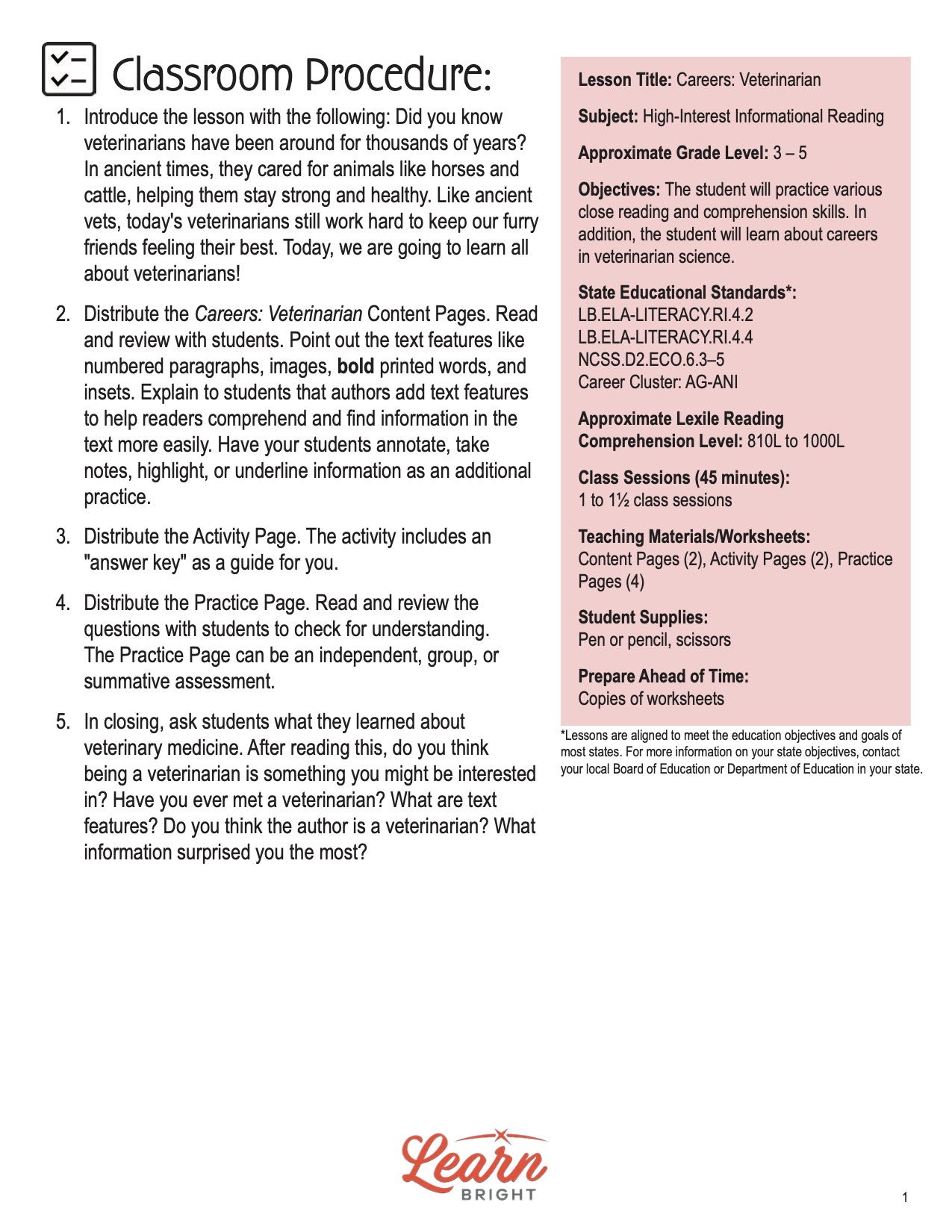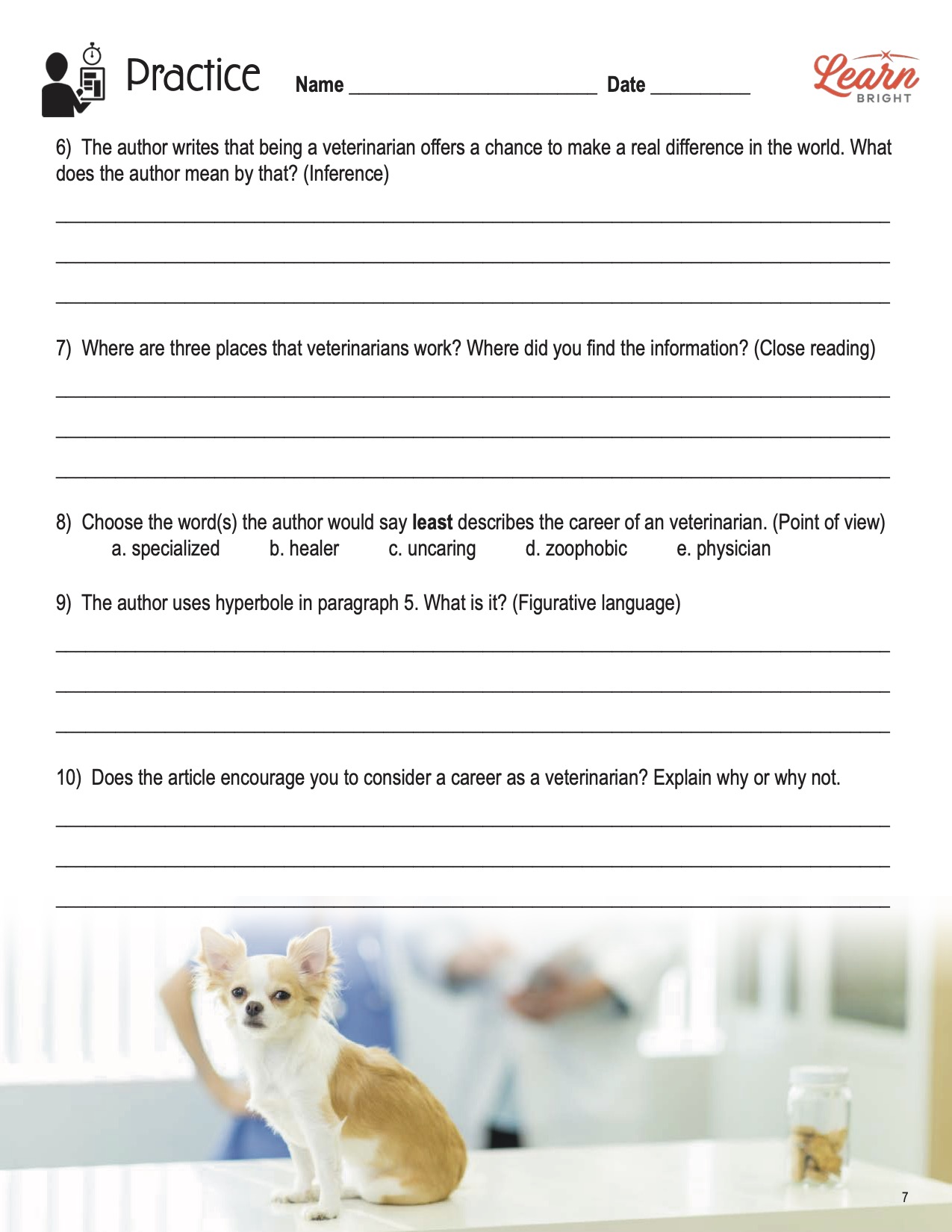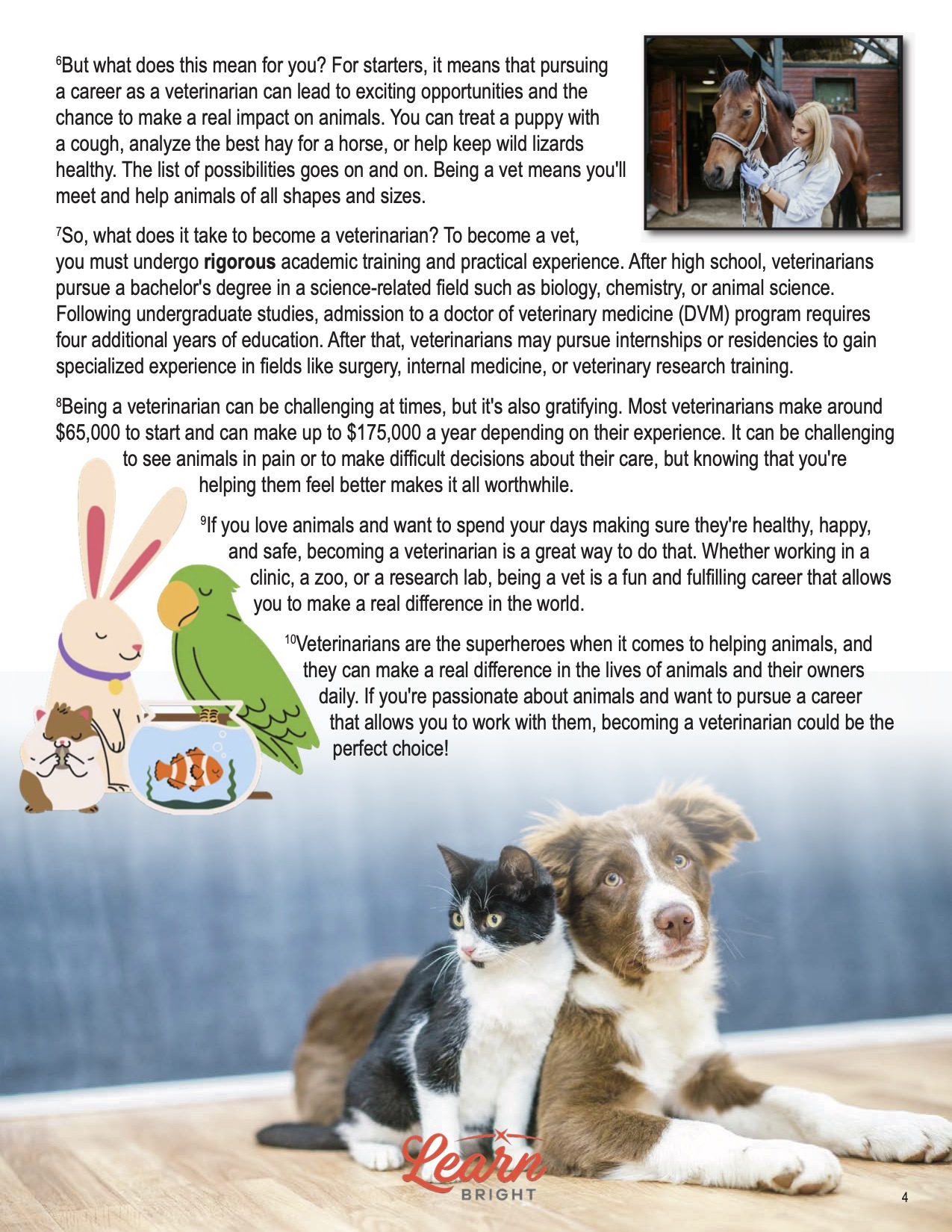Description
What our Careers: Veterinarian lesson plan includes
Lesson Objectives and Overview: Careers: Veterinarian is a high-interest reading comprehension lesson plan. As such, students will practice various close reading and comprehension skills. In addition, they will will learn about careers in the field of veterinarian science. This lesson is for students in 3rd grade, 4th grade, and 5th grade.
Classroom Procedure
Every lesson plan provides you with a classroom procedure page that outlines a step-by-step guide to follow. You do not have to follow the guide exactly. The guide helps you organize the lesson and details when to hand out worksheets. It also lists information in the yellow box that you might find useful. You will find the lesson objectives, state standards, and number of class sessions the lesson should take to complete in this area. In addition, it describes the supplies you will need as well as what and how you need to prepare beforehand.
Teacher Notes
The teacher notes page provides an extra paragraph of information to help guide the lesson. It explains that you can teach this lesson in a whole-class setting or as an independent, small-group activity. You can use the blank lines to write down any other ideas or thoughts you have about the topic as you prepare.
CAREERS: VETERINARIAN LESSON PLAN CONTENT PAGES
Intro to Veterinarians
The Careers: Veterinarian lesson plan contains two content pages. You might be wondering why we are talking about the career of a veterinarian when you’re just a kid. Well, guess what? It’s never too soon to start thinking about what you might want to do when you grow up. Veterinarians are animal doctors who care for pets, farm animals, zoo animals, and even wild animals. They help keep animals healthy and treat them when they’re sick or hurt. If you love animals and want to make a difference in their lives, becoming a veterinarian could be the perfect job!
Veterinarians have busy days filled with all kinds of tasks. They work with various animals, from tiny hamsters to giant elephants! In a typical day, they might start by checking on sick pets in the morning, then perform surgeries in the afternoon, and even help deliver baby animals, such as puppies or kittens. Every day is different, but it’s always exciting and rewarding.
What Vets Do
Like other doctors, veterinarians use lots of cool tools to help them care for their animal patients. They use stethoscopes to listen to heartbeats and X-ray machines to see inside the animals’ bodies. Add in all the other tools, vets have everything they need to diagnose and treat their patients. They also use special instruments for surgeries, like scalpels and sutures, that help animals heal.
Just like doctors, veterinarians can specialize in different areas of medicine. Some vets focus on treating certain types of animals, like horses or birds. In contrast, others specialize in surgery, dentistry, or emergency medicine. There’s something for everyone in the world of veterinary medicine! Specializing allows vets to become experts in their chosen field and provide the best possible care for their patients. Whether working with exotic animals in a zoo or caring for family pets in a clinic, specialized veterinarians play an important role in keeping animals healthy and happy.
Vets work in places like animal hospitals, zoos, and even government offices. In animal hospitals, they take care of pets, while in zoos, they help exotic animals stay healthy. Some vets also work in labs to study animal diseases, and others ensure food safety and animal welfare for the government. There are a zillion places where veterinarians can work.
But what does this mean for you? For starters, it means that pursuing a career as a veterinarian can lead to exciting opportunities and the chance to make a real impact on animals. You can treat a puppy with a cough, analyze the best hay for a horse, or help keep wild lizards healthy. The list of possibilities goes on and on. Being a vet means you’ll meet and help animals of all shapes and sizes.
How to Become a Veterinarian
So, what does it take to become a veterinarian? To become a vet, you must undergo rigorous academic training and practical experience. After high school, veterinarians pursue a bachelor’s degree in a science-related field such as biology, chemistry, or animal science. Following undergraduate studies, admission to a doctor of veterinary medicine (DVM) program requires four additional years of education. After that, veterinarians may pursue internships or residencies to gain specialized experience in fields like surgery, internal medicine, or veterinary research training.
Being a veterinarian can be challenging at times, but it’s also gratifying. Most veterinarians make around $65,000 to start and can make up to $175,000 a year depending on their experience. It can be challenging to see animals in pain or to make difficult decisions about their care, but knowing that you’re helping them feel better makes it all worthwhile.
Why Being a Veterinarian is Worth It
If you love animals and want to spend your days making sure they’re healthy, happy, and safe, becoming a veterinarian is a great way to do that. Whether working in a clinic, a zoo, or a research lab, being a vet is a fun and fulfilling career that allows you to make a real difference in the world.
Veterinarians are the superheroes when it comes to helping animals, and they can make a real difference in the lives of animals and their owners daily. If you’re passionate about animals and want to pursue a career that allows you to work with them, becoming a veterinarian could be the perfect choice!
CAREERS: VETERINARIAN LESSON PLAN WORKSHEETS
The Careers: Veterinarian lesson plan includes two worksheets: an activity worksheet and a practice worksheet. Each one will help students solidify their grasp of the material they learned throughout the lesson. You can refer to the classroom procedure guidelines to know when to hand out each worksheet.
ANIMAL MYSTERIES ACTIVITY WORKSHEET
For this activity, students will pretend to be veterinarians. With a partner, they will read through six scenarios in which an animal appears to have some sort of problem. Students will discuss with each other what they would suggest to help the animal in each scenario.
CAREERS: VETERINARIAN PRACTICE WORKSHEET
The practice worksheet lists 10 questions based on the content. These questions all relate to the content pages, so students will need to refer to them often for the answers. In addition, each question provides which reading tool the question corresponds to, such as text feature, vocabulary, or comprehension.
Worksheet Answer Keys
At the end of the lesson plan document are answer keys for the practice worksheet as well as the activity. Given the nature of the activity, the responses provided on the answer key are just possible responses students might think of. They are more like guidelines to help students understand how to think as a veterinarian. The correct answers are all in red to make it easier for you to compare them with students’ responses. If you choose to administer the lesson pages to your students via PDF, you will need to save a new file that omits these pages. Otherwise, you can simply print out the applicable pages and keep these as reference for yourself when grading assignments.









